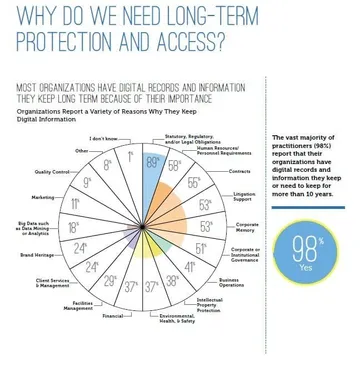Integrating Long-Term Digital Preservation into Your Information Governance Program: First Steps
 Lori Ashley
•
November 6, 2017
Lori Ashley
•
November 6, 2017
The 2016 IGI Benchmark Report on The Governance of Long-term Digital Information confirmed that nearly all organizations represented have digital records and information that keep or need to keep in excess of 10 years. More importantly, IG practitioners who participated in the survey indicated that they were aware hardware and software obsolescence represents a threat to the usability and readability of long-term digital information and records.
One year later, Preservica and IGI teamed up again to assess the value side of the long-term digital preservation equation, and to dig deeper in order to identify specific functions and systems where these information assets are produced and stored. We confirmed that long-term digital content is spread far and wide across the enterprise, from file shares and collaboration environments, to line of business applications. This reality can be overwhelming, but based on the strength of the response by 83% of respondents that business value is a major driver for long-term preservation and governance, there is no option but to forge ahead to promote the long-view and integrate supporting capabilities in the Information Governance program.
I recently spoke with the IG director for a global financial services firm about progress in addressing long-term digital information. I’ll share highlights of our conversation and pass along recommended actions for others who may be working to integrate long-term digital preservation capabilities into their enterprise information governance programs.
I began by asking for her perspective on Information Governance, and she referred to IGI’s definition: Information governance is the activities and technologies that organizations employ to maximize the value of their information while minimizing associated risks and costs. We walked through the pinwheel of reasons organizations keep information long-term to determine which ones applied in her organization: every one of them made the list. It was powerful to validate how many different areas of the business rely on long-term information to support business decisions and client relationships.

A recent update of her organization’s records retention schedule, which includes a number of series that are retained for “life of firm,” provided a way to engage directly with record creators and other users about their requirements. No specific digital preservation strategies, however, have yet been deployed for permanent and long-term digital records. For the time being, long-term digital preservation is a future area of focus on the IG roadmap. She specifically noted, however, that the organization is fast approaching a major milestone in its corporate history, and that there is board support for establishing an archive of historical materials.
The IG Director shared that she has strong support from the legal and information technology functions, and that she has increasingly gained visibility as a resource and subject matter expert. The pace of progress is tempered by the small size of her staff, and she hopes to see an increase in resources to expand the IG program. Leadership is aware that secure, authenticated access to digital information is vital for decision making, meeting compliance and legal requirements, and sustaining client relationships.
In wrapping up our discussion, the IG Director shared ideas for how to keep an IG program moving forward:
1) Build relationships with the business by educating yourself on their requirements, and sharing your expertise on good RIM practices
2) Expand the focus beyond records management and look for opportunities to educate stakeholders about the unique characteristics of the digital information assets
3) Be prepared to articulate the value as well as the risks of digital information
4) Identify a digital preservation strategy and capabilities as an integral component of your IG roadmap
5) Learn about your organization’s current archiving practices so that you can help identify gaps that threaten access and re-use of valued digital information
Useful Resources and Tools
Download the Information Governance Initiative (IGI) benchmark report and the 2017 benchmark highlights.
Check out our Digital Value at Risk (DVAR) Calculator to help identify high risk/high value collections of information assets and assess the risks and financial consequences of loss.
Contact Preservica at email hidden; JavaScript is required if you’d like to discuss how active digital preservation fits into your Information Governance program.




